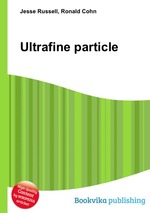Ultrafine particle
Jesse Russell Ronald Cohn
бумажная книга
High Quality Content by WIKIPEDIA articles! Ultrafine particles (UFPs) are nanoscale, less than 100 nanometres. Regulations do not exist for this size class of ambient air pollution particles, which are far smaller than the regulated PM10 and PM2.5 particle classes and are believed to have several more aggressive health implications than those classes of larger particulates. There are two main divisions that categorize types of UFPs. UFPs can either be carbon-based or metallic, and then can be further subdivided by their magnetic properties. Electron microscopy and special physical lab conditions allow scientists to observe UFP morphology. Airborne UFPs can be measured using a condensation particle counter, in which particles are mixed with alcohol vapor and then cooled allowing the vapor to condense around them which are then counted using a light scanner. UFPs are both manufactured and naturally occurring. UFPs are the main constituent of airborne particulate matter. Due to their numerous quantity and ability to penetrate deep within the lung, UFPs are a major concern for respiratory exposure and health.


